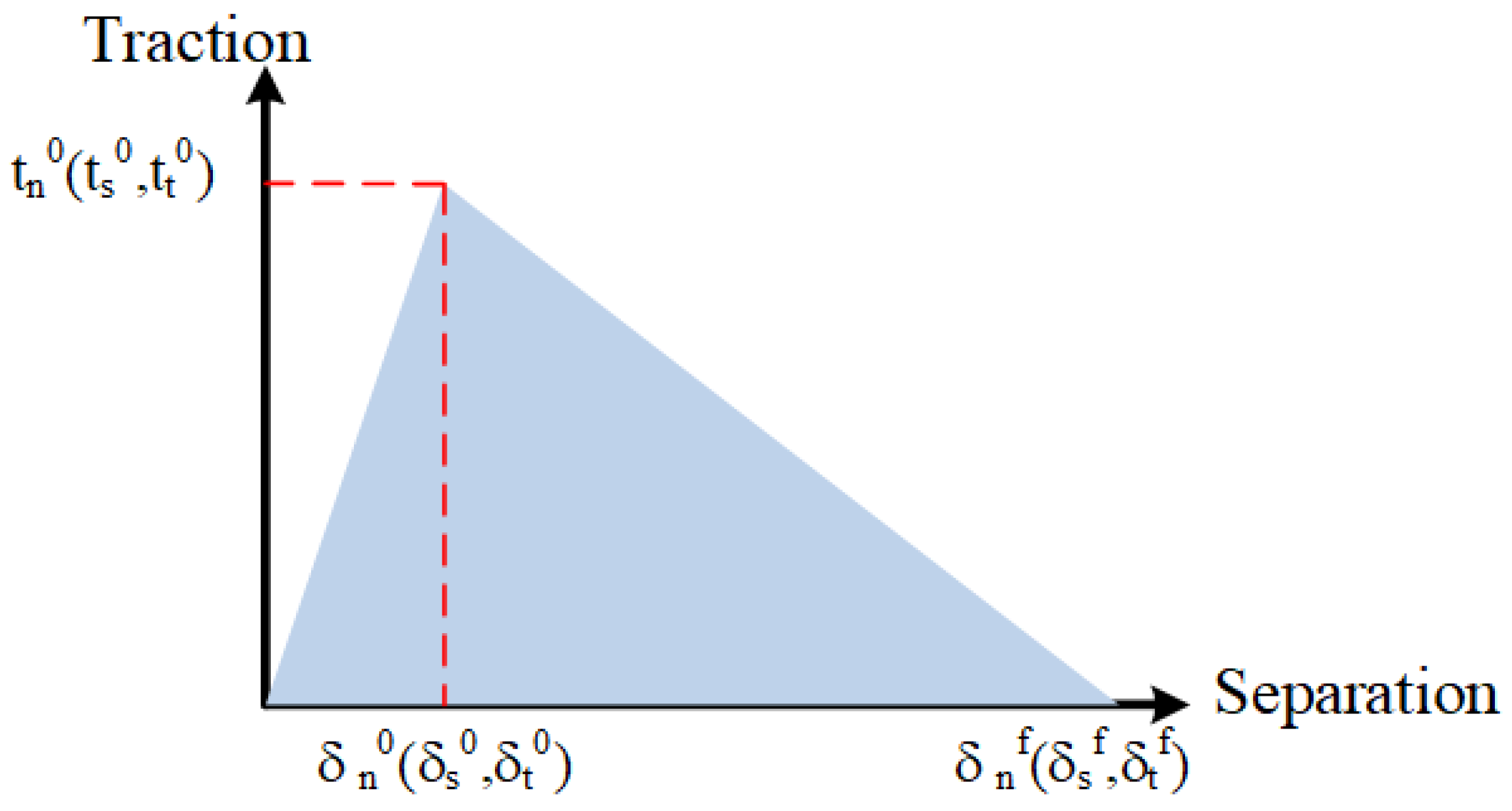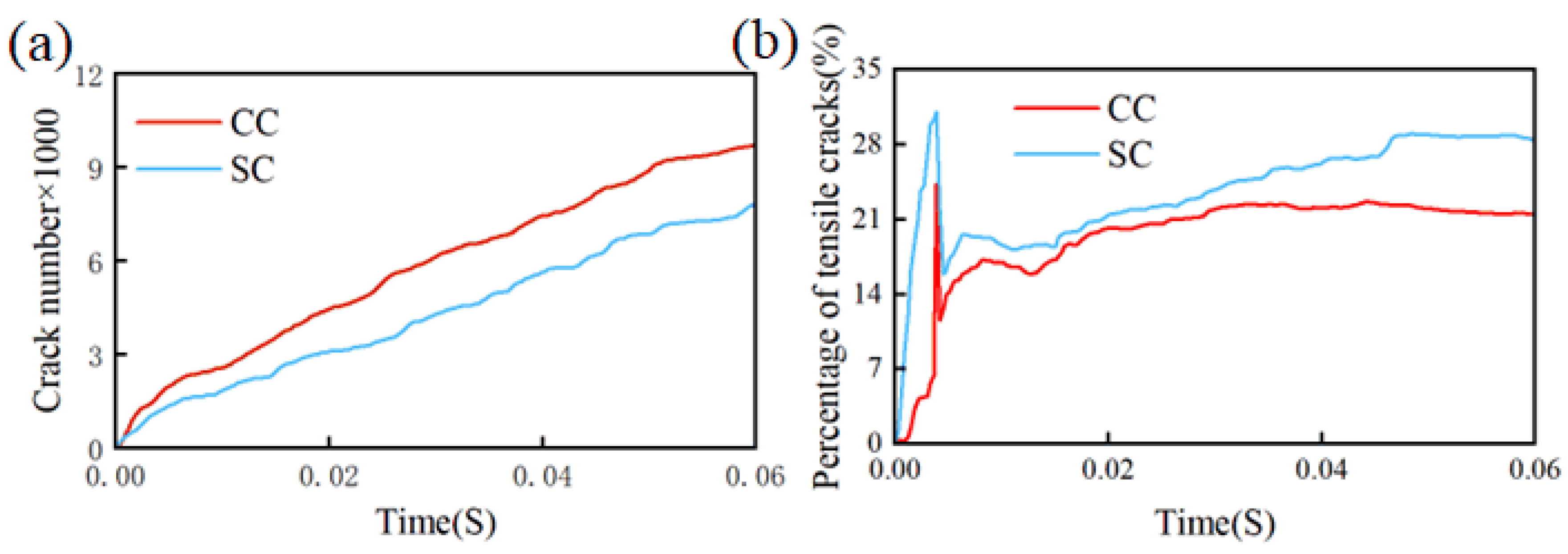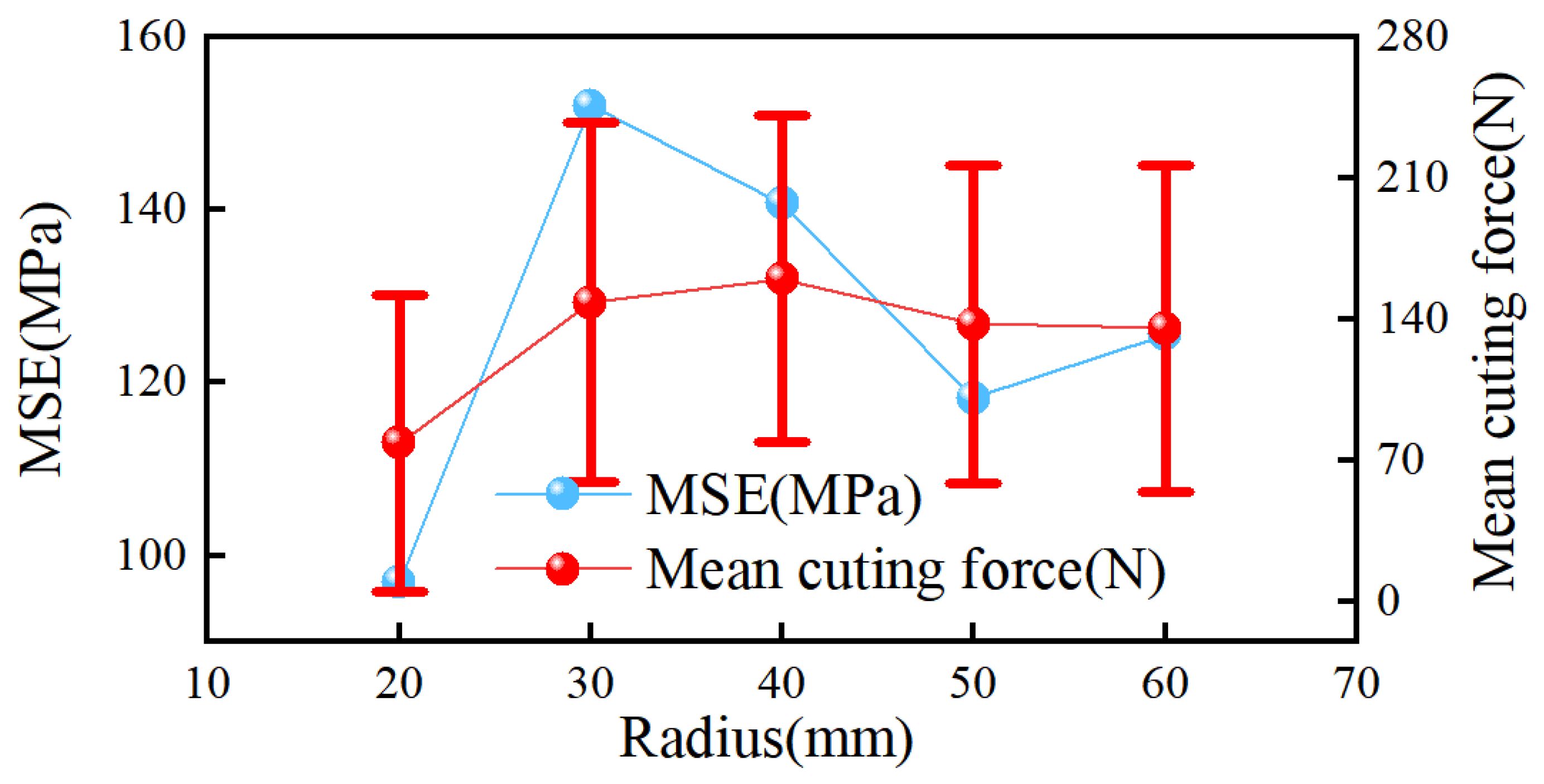Numerical Simulation of Rock Cracking Using Saddle Polycrystalline Diamond Compact Cutters Considering Confined Pressure and Mechanism of Speed Increase
Abstract
1. Introduction
2. Establishment of Model
2.1. Cohesive Zone
2.2. Mechanical Specific Energy
2.3. Establishment and Verification of Finite Element Model
3. Results and Discussion
3.1. Rock Breaking Mechanism
3.2. Different Confined Pressures and Hydrostatic Pressure
3.3. Different Back Rake Angles
3.4. Influence of Different Arc Radii on SC Rock Breaking
4. Conclusions
- (1)
- Compared to conventional PDC cutters, the ridge-like structure of saddle-shaped cutters more effectively concentrates rock-breaking stresses, facilitating the initiation of cracks in the rock. Simultaneously, the arcuate structure of saddle-shaped cutters favors the generation of tensile cracks in the rock, thereby making the generation of rock chips during the rock-breaking process more likely. Consequently, the total number of rock cracks produced during the rock-breaking process with saddle-shaped cutters is lower than that of conventional PDC cutters, and the proportion of tensile cracks is higher. This represents the key to the high efficiency of rock breaking achieved with saddle-shaped cutters.
- (2)
- The increase in confined pressure inhibits the generation of tensile cracks during the rock-breaking process with PDC cutters while simultaneously promoting the formation of more microcracks, dispersing rock-breaking energy and reducing the cutter’s rock-breaking efficiency. However, in comparison, the ridge-like and arcuate structures of saddle-shaped PDC cutters ensure a higher proportion of tensile cracks in rocks under high confined pressure, helping to suppress the formation of microcracks. Therefore, saddle-shaped PDC cutters are more suitable for drilling in deep hard formations.
- (3)
- Under constant conditions, as the back rake angle of saddle-shaped cutters increases, the total number of rock-breaking cracks first decreases and then increases, whereas the proportion of tensile cracks exhibits an inverse trend. Based on this observation, it is recommended to utilize a back rake angle range of 15° to 20° for saddle-shaped cutters in deep, hard formations.
- (4)
- The arc radius significantly impacts the generation of rock-breaking cracks by saddle-shaped cutters. When the arc radius is 20 mm, saddle-shaped cutters produce the most tensile cracks and achieve the highest rock-breaking efficiency. However, with this size, the arc tip is relatively weak, potentially affecting the fatigue life. Therefore, an arc radius between 50 mm and 60 mm is recommended. Additionally, this analysis suggests an optimization direction for saddle-shaped cutters with an arc radius of 20 mm: modifying the shape from an arc to an arc–straight–arc configuration to enhance the strength at the weak arc position.
Author Contributions
Funding
Data Availability Statement
Conflicts of Interest
References
- Cai, M.; Tan, L.; Tan, B.; Luo, X.; Zeng, J.; Mao, D.; Lin, Q. Experimental and numerical study on the dynamic characteristics of full-size PDC bit. Mech. Syst. Signal Process. 2023, 200, 110560. [Google Scholar] [CrossRef]
- Zuo, W.; Shi, F.; Manlapig, E. Electrical breakdown channel locality in high voltage pulse breakage. Miner. Eng. 2012, 69, 196–204. [Google Scholar] [CrossRef]
- Lund, J.W.; Toth, A. Direct Utilization of Geothermal Energy 2020 Worldwide Review. Geothermics 2021, 90, 101915. [Google Scholar] [CrossRef]
- Guzek, A.; Shufrin, I.; Pasternak, E.; Dyskin, A.V. Influence of drilling mud rheology on the reduction of vertical vibrations in deep rotary drilling. J. Pet. Sci. Eng. 2015, 135, 375–383. [Google Scholar] [CrossRef]
- Wu, Z.; Yuan, R.; Zhang, W.; Hu, S.; Jiang, W. Numerical Simulation and Field Test of a PDC Bit with Mixed Cutter Arrangement to Break Non-Homogeneous Granite. Appl. Sci. 2023, 13, 9133. [Google Scholar] [CrossRef]
- Liu, J.; Zheng, H.; Kuang, Y.; Xie, H.; Qin, C. 3D Numerical Simulation of Rock Cutting of an Innovative Non-Planar Face PDC Cutter and Experimental Verification. Appl. Sci. 2019, 9, 4372. [Google Scholar] [CrossRef]
- Fu, X.; Huang, Z.; Shi, H.; Song, H.; Wu, H. Comparison of fracture characteristics of different PDC cutters penetrating carbonate rock. Geoenergy Sci. Eng. 2023, 223, 211536. [Google Scholar] [CrossRef]
- Shao, F.; Liu, W.; Gao, D.; Ye, Y. Study on rock-breaking mechanism of axe-shaped PDC cutter. J. Pet. Sci. Eng. 2021, 205, 108922. [Google Scholar] [CrossRef]
- Shao, F.; Liu, W.; Gao, D.; Zhao, X. Development and Verification of Triple-Ridge-Shaped Cutter for PDC Bits. SPE J. 2022, 27, 3849–3863. [Google Scholar] [CrossRef]
- Zeng, Y.; He, W.; Zhang, Z.; Shi, H.; Zhou, J.; Ding, S.; Ma, G. Rock-breaking performances of innovative triangular-shaped polycrystalline diamond compact cutter. Rev. Sci. Instrum. 2021, 92, 035115. [Google Scholar] [CrossRef] [PubMed]
- He, W.; Zhang, R.; Liu, L.; Chen, Z.; Shi, H.; Huang, Z.; Xiong, C.; Li, X.; Sun, J.; Hu, C. Numerical simulation of rock-breaking mechanisms by triple-ridged PDC cutter in hard rocks. Geoenergy Sci. Eng. 2023, 229, 212148. [Google Scholar] [CrossRef]
- Wu, Z.; Yuan, R.; Zhang, W.; Liu, J.; Hu, S. Structure Design of Bionic PDC Cutter and the Characteristics of Rock Breaking Processes. Processes 2023, 12, 66. [Google Scholar] [CrossRef]
- Zhu, X.; Luo, Y.; Liu, W.; Yang, F.; Li, Z.; Lu, D. Rock cutting mechanism of special-shaped PDC cutter in heterogeneous granite formation. J. Pet. Sci. Eng. 2022, 210, 110020. [Google Scholar] [CrossRef]
- Xiong, C.; Huang, Z.; Yang, R.; Sheng, M.; Shi, H.; Dai, X.; Wu, X.; Zhang, S. Comparative analysis cutting characteristics of stinger PDC cutter and conventional PDC cutter. J. Pet. Sci. Eng. 2020, 189, 106792. [Google Scholar] [CrossRef]
- Chen, P.; Meng, M.; Miska, S.; Yu, M.; Ozbayoglu, E.; Takach, N. Study on integrated effect of PDC double cutters. J. Pet. Sci. Eng. 2019, 178, 1128–1142. [Google Scholar] [CrossRef]
- Li, S.; Zhu, X.; Liang, K.; Deng, Y.; Liu, H. Numerical simulation study on optimizing the conical cutter bit to break deep strata. Recent Pat. Eng. 2024, 18, e110523216781. [Google Scholar] [CrossRef]
- Peng, Q.; Zhou, Y.; Yu, J.; Yang, X.; Liu, Y.; Ma, C.; Cheng, C.; Ke, X. Study on rock breaking efficiency of special shaped cutters. IOP Conf. Ser. Earth Environ. Sci. 2022, 983, 012089. [Google Scholar] [CrossRef]
- Xiong, C.; Huang, Z.; Shi, H.; Chen, H.; Chen, Z.; He, W.; Zhang, B. Investigations on the Stinger PDC cutter breaking granitoid under in-situ stress and hydrostatic pressure conditions. Int. J. Rock Mech. Min. Sci. 2023, 164, 105312. [Google Scholar] [CrossRef]
- Xiong, C.; Huang, Z.-W.; Shi, H.-Z.; Yang, R.-Y.; Wu, G.; Chen, H.; He, W.-H. Performances of a Stinger PDC cutter breaking granite: Cutting force and mechanical specific energy in single cutter tests. Pet. Sci. 2023, 20, 1087–1103. [Google Scholar] [CrossRef]
- Liu, W.; Meng, X.; Weng, X.; Shen, X.; Zhu, X. Rock-breaking performance of specially-shaped PDC cutters from a new insight into the damage beneath cutting groove. Geoenergy Sci. Eng. 2023, 231, 212326. [Google Scholar] [CrossRef]
- Zhu, X.; Li, R.; Liu, W.; He, C. Analysis of Rock-Breaking Mechanism and Drillstring Dynamics of an Innovative Multi-Ridge-Curve-Shaped PDC Cutter. Arab. J. Sci. Eng. 2023, 48, 16587–16606. [Google Scholar] [CrossRef]
- Liu, W.; Deng, H.; Liu, Y.; Chen, X.; He, C.; Zhu, X. Experimental investigation of the rock cutting process with blunt PDC cutters. Geoenergy Sci. Eng. 2023, 226, 211803. [Google Scholar] [CrossRef]
- Liu, W.; Deng, K.; Yang, F.; Luo, Y.; Zhu, X. An experimental and numerical investigation on rock cutting behavior of specially-shaped PDC cutter. J. Mech. Sci. Technol. 2024, 38, 285–298. [Google Scholar] [CrossRef]
- Wei, J.; Liu, W.; Gao, D.; Guo, D. Effect of Polishing on Cutting Efficiency and Mechanical Properties of PDC Cutters. SPE J. 2024, 29, 700–713. [Google Scholar] [CrossRef]
- Xi, Y.; Wang, H.-Y.; Zha, C.-Q.; Li, J.; Liu, G.-H.; Guo, B.-Y. Numerical simulation of rock-breaking and influence laws of dynamic load parameters during axial-torsional coupled impact drilling with a single PDC cutter. Pet. Sci. 2023, 20, 1806–1827. [Google Scholar] [CrossRef]
- Ke, X.; Sun, J.; Yang, X.; Ma, C.; Yu, J.; Huang, K. Cutting mechanism of a special 3D concave-shaped PDC cutter applicable to the Weiyuan shale. J. Pet. Explor. Prod. Technol. 2023, 13, 1435–1451. [Google Scholar] [CrossRef]
- Zhang, Z.; Zhao, D.; Zhao, Y.; Gao, K.; Zhang, C.; Lü, X. 3D numerical simulation study of rock breaking of the wavy PDC cutter and field verification. J. Pet. Sci. Eng. 2021, 203, 108578. [Google Scholar] [CrossRef]
- Zhang, Z.; Zhao, D.; Zhao, Y.; Zhou, Y.; Tang, Q.; Han, J. Simulation and experimental study on temperature and stress field of full-sized PDC bits in rock breaking process. J. Pet. Sci. Eng. 2020, 186, 106679. [Google Scholar] [CrossRef]
- Yao, J.; Liu, B.; Zhu, H. Discrete Element Study on Rock Failure Mechanism by Shaped PDC Cutter Under Formation Conditions with In-Situ Stress and Temperature. In Proceedings of the ARMA/DGS/SEG International Geomechanics Symposium, Abu Dhabi, United Arab Emirates, 7–10 November 2022. [Google Scholar] [CrossRef]
- Zhu, X.; Luo, Y.; Liu, W.; He, L.; Gao, R.; Jia, Y. On the Mechanism of High-Voltage Pulsed Fragmentation from Electrical Breakdown Process. Rock Mech. Rock Eng. 2021, 54, 4593–4616. [Google Scholar] [CrossRef]
- Labra, C.; Rojek, J.; Oñate, E. Discrete/Finite Element Modelling of Rock Cutting with a TBM Disc Cutter. Rock Mech. Rock Eng. 2017, 50, 621–638. [Google Scholar] [CrossRef]
- Liu, X.; Zou, D.; Chen, Y.; Huang, Y.; Wang, Q. Analysis of PDC cutter cutting-broken conglomerate based on the discrete element method. Energy Sci. Eng. 2022, 10, 3580–3591. [Google Scholar] [CrossRef]
- Jiang, H.; Meng, D. 3D numerical modelling of rock fracture with a hybrid finite and cohesive element method. Eng. Fract. Mech. 2018, 199, 280–293. [Google Scholar] [CrossRef]
- Wang, H.; Liao, H.; He, Y.; Niu, W.; Wei, J.; Niu, J.; Gao, F. Experimental and numerical simulation study on the effect of granite grooving characteristics on PDC cutter cutting performance. Geoenergy Sci. Eng. 2023, 230, 212256. [Google Scholar] [CrossRef]
- Su, X.T.; Yang, Z.J.; Liu, G.H. Monte Carlo simulation of complex cohesive fracture in random heterogeneous quasi-brittle materials: A 3D study. Int. J. Solids Struct. 2010, 47, 2336–2345. [Google Scholar] [CrossRef]
- Zhao, Y.; Zhang, C.; Zhang, Z.; Gao, K.; Li, J.; Xie, X. The rock breaking mechanism analysis of axial ultra-high frequency vibration assisted drilling by single PDC cutter. J. Pet. Sci. Eng. 2021, 205, 108859. [Google Scholar] [CrossRef]
- Jaime, M.C.; Zhou, Y.; Lin, J.-S.; Gamwo, I.K. Finite element modeling of rock cutting and its fragmentation process. Int. J. Rock Mech. Min. Sci. 2015, 80, 137–146. [Google Scholar] [CrossRef]
- Xie, Y.; Wu, X.; Hou, Z.; Li, Z.; Luo, J.; Lüddeke, C.T.; Huang, L.; Wu, L.; Liao, J. Gleaning insights from German energy transition and large-scale underground energy storage for China’s carbon neutrality. Int. J. Min. Sci. Technol. 2023, 33, 529–553. [Google Scholar] [CrossRef]
- Zeng, Y.; Liu, W.; Ding, S.; Zhu, X. Numerical simulation analysis of hybrid impact cutting and its comparison with torsional impact cutting. J. Vibroeng. 2020, 22, 451–464. [Google Scholar] [CrossRef]
- Cheng, Z.; Sheng, M.; Li, G.; Huang, Z.; Shi, H.; Dai, X.; Guo, Z. Cracks imaging in linear cutting tests with a PDC cutter: Characteristics and development sequence of cracks in the rock. J. Pet. Sci. Eng. 2019, 179, 1151–1158. [Google Scholar] [CrossRef]
- Wei, J.; Liu, W.; Gao, D. Mechanism Analysis and Mathematical Modeling of Brittle Failure in Rock Cutting with a Single Sharp Cylinder-Shaped PDC Cutter. SPE J. 2023, 29, 651–669. [Google Scholar] [CrossRef]
- Li, W.; Ling, X.; Pu, H. Development of a Cutting Force Model for a Single PDC Cutter Based on the Rock Stress State. Rock Mech. Rock Eng. 2020, 53, 185–200. [Google Scholar] [CrossRef]
- Yao, Y. Linear Elastic and Cohesive Fracture Analysis to Model Hydraulic Fracture in Brittle and Ductile Rocks. Rock Mech. Rock Eng. 2012, 45, 375–387. [Google Scholar] [CrossRef]
- Yang, F.; Liu, W.; Zhu, X.; Xiang, C. The Rock-Breaking Mechanism of Thermal Spalling-Assisted Rock Cutting by PDC Cutter. Rock Mech. Rock Mech. Rock Eng. 2024, 57, 993–1012. [Google Scholar] [CrossRef]



















| CZEs Material Parameter | Numerical Value |
|---|---|
| Initial normal stiffness /(MPa·mm−1) | 80,000 |
| Peak normal tractive force /MPa | 14.70 |
| Type I fracture energy /(N·mm−1) | 0.230 |
| Initial tangential stiffness /(MPa·mm−1) | 40,000 |
| /MPa | 45.20 |
| Type II fracture energy /(N·mm−1) | 0.426 |
Disclaimer/Publisher’s Note: The statements, opinions and data contained in all publications are solely those of the individual author(s) and contributor(s) and not of MDPI and/or the editor(s). MDPI and/or the editor(s) disclaim responsibility for any injury to people or property resulting from any ideas, methods, instructions or products referred to in the content. |
© 2024 by the authors. Licensee MDPI, Basel, Switzerland. This article is an open access article distributed under the terms and conditions of the Creative Commons Attribution (CC BY) license (https://creativecommons.org/licenses/by/4.0/).
Share and Cite
Wu, Z.; Cheng, Y.; Yuan, R. Numerical Simulation of Rock Cracking Using Saddle Polycrystalline Diamond Compact Cutters Considering Confined Pressure and Mechanism of Speed Increase. Processes 2024, 12, 1450. https://doi.org/10.3390/pr12071450
Wu Z, Cheng Y, Yuan R. Numerical Simulation of Rock Cracking Using Saddle Polycrystalline Diamond Compact Cutters Considering Confined Pressure and Mechanism of Speed Increase. Processes. 2024; 12(7):1450. https://doi.org/10.3390/pr12071450
Chicago/Turabian StyleWu, Zebing, Yuyao Cheng, and Ruofei Yuan. 2024. "Numerical Simulation of Rock Cracking Using Saddle Polycrystalline Diamond Compact Cutters Considering Confined Pressure and Mechanism of Speed Increase" Processes 12, no. 7: 1450. https://doi.org/10.3390/pr12071450
APA StyleWu, Z., Cheng, Y., & Yuan, R. (2024). Numerical Simulation of Rock Cracking Using Saddle Polycrystalline Diamond Compact Cutters Considering Confined Pressure and Mechanism of Speed Increase. Processes, 12(7), 1450. https://doi.org/10.3390/pr12071450






